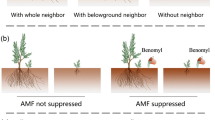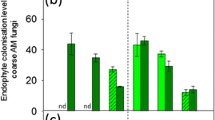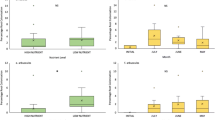Abstract
Aims
We tested whether a nurse-plant effect depends on target-seedling tolerance to soil acidity and arbuscular mycorrhizal fungi (AMF) in an acid soil.
Methods
A mesocosm experiment was used to assess the acid-tolerance of the seedlings of four target species. Field experiment 1 tested the nurse effects of an adult plant (Lespedeza formosa) on germination rate, seedling survival rate, growth and AMF colonization rate of target seedlings growing in an acid soil. Field experiment 2 tested the influence of AMF root colonization on nurse-plant effects.
Results
Target species greatly varied in their tolerance to soil acidity while nurse-effect on target species were mediated by target species acid-tolerance and AMF root colonization. In field experiment 1, as expected, nurse-effect was positive for acid-sensitive species and negative for acid-tolerant species. While nurse plant presence facilitated the germination, survival, growth, and AMF colonization of the two acid-sensitive species it competed with the two acid-tolerant species. In field experiment 2, the nurse plant facilitated the growth of the acid-sensitive seedlings more under AMF not suppressed treatment than AMF suppressed treatment. For the acid-tolerant seedlings, however, the nurse plant reduced their growth under AMF not suppressed treatment, but did not affect their growth under AMF suppressed treatment.
Conclusion
Nurse plant facilitated the acid-sensitive species in an acid soil, and the facilitation was enhanced by increasing AMF in the soil. These findings highlight how acid-tolerance of target species and AMF colonization mediates nurse plant facilitation and has important implications for the use of nurse plants in the restoration of acid soils ecosystems.






Similar content being viewed by others
References
Abbott LK, Robson AD (1985) Formation of external hyphae in soil by 4 species of vesicular arbuscular mycorrhizal fungi. New Phytol 99:245–255
An GH, Miyakawa S, Kawahara A, Osaki M, Ezawa T (2008) Community structure of arbuscular mycorrhizal fungi associated with pioneer grass species Miscanthus sinensis in acid sulfate soils: habitat segregation along pH gradients. Soil Sci Plant Nutr 54:517–528
Armas C, Ordiales R, Pugnaire FI (2004) Measuring plant interactions: a new comparative index. Ecology 85:2682–2686
Arredondo-Núñez A, Badano EI, Bustamante RO (2009) How beneficial are nurse plants? A meta-analysis of the effects of cushion plants on high-Andean plant communities. Commun Ecol 10:1–6
Arroyo AI, Pueyo Y, Saiz H, Alados CL (2015) Plant-plant interactions as a mechanism structuring plant diversity in a Mediterranean semi-arid ecosystem. Ecol Evol 5:5305–5317
Badano EI, Cavieres LA (2006) Impacts of ecosystem engineers on community attributes: effects of cushion plants at different elevations of the Chilean Andes. Divers Distrib 12:388–396
Basak BB, Biswas DR (2016) Potentiality of Indian rock phosphate as liming material in acid soil. Geoderma 263:104–109
Booth MG (2004) Mycorrhizal networks mediate overstorey-understorey competition in a temperate forest. Ecol Lett 7:538–546
Booth MG, Hoeksema JD (2010) Mycorrhizal networks counteract competitive effects of canopy trees on seedling survival. Ecology 91:2294–2302
Boughton EH, Quintana-Ascencio PF, Bohlen PJ, Nickerson D (2011) Differential facilitative and competitive effects of a dominant macrophyte in grazed subtropical wetlands. J Ecol 99:1263–1271
Brooker RW, Maestre FT, Callaway RM, Lortie CL, Cavieres LA, Kunstler G, Liancourt P, Tielborger K, Travis JMJ, Anthelme F, Armas C, Coll L, Corcket E, Delzon S, Forey E, Kikvidze Z, Olofsson J, Pugnaire F, Quiroz CL, Saccone P, Schiffers K, Seifan M, Touzard B, Michalet R (2008) Facilitation in plant communities: the past, the present, and the future. J Ecol 96:18–34
Callaway RM (1995) Positive interactions among plants. Bot Rev 61:306–349
Callaway RM (1998) Are positive interactions species-specific? Oikos 82(1):202
Callaway RM, Kikodze D, Chiboshvili M, Khetsuriani L (2005) Unpalatable plants protect neighbors from grazing and increase plant community diversity. Ecology 86:1856–1862
Callaway RM, Thelen GC, Barth S, Ransey P, Gannon JE (2004) Soil fungi alter interactions between the invader Centaurea maculosa and north American natives. Ecology 85:1062–1071
Castro J, Zamora R, Hodar JA, Gomez JM (2002) Use of shrubs as nurse plants: a new technique for reforestation in mediterranean mountains. Restor Ecol 10:297–305
Cavieres LA, Badano EI, Sierra-Almeida A, Molina-Montenegro MA (2007) Microclimatic modifications of cushion plants and their consequences for seedling survival of native and non-native herbaceous species in the high Andes of Central Chile. Arct Antarct Alp Res 39:229–236
Collins B, Wein G (2000) Stem elongation response to neighbour shade in sprawling and upright Polygonum species. Ann Bot 86:739–744
Coughlan AP, Dalpe Y, Lapointe L, Piche Y (2000) Soil pH- induced changes in root colonization, diversity and reproduction of symbiotic arbuscular mycorrhizal fungi from healthy and declining maple forests. Can J For Res 30:1543–1554
de Lucas A, Panter S, Mouradov A, Rochfort S, Smith KF, Spangenberg G (2015) Assessment of nutritional characteristics of virus-resistant transgenic white clover (Trifolium repens L.) grown under field and glasshouse conditions. Mol Breed 35:147
Dehaan LR, Ehlke NJ, Sheaffer CC, Wyse DL, Dehaan RL (2006) Evaluation of diversity among north American accessions of false indigo (Amorpha fruticosa L.) for forage and biomass. Genet Resour Crop Evol 53:1463–1476
Duponnois R, Ouahmane L, Kane A, Thioulouse J, Hafidi M, Boumezzough A, Prin Y, Baudoin E, Galiana A, Dreyfus B (2011) Nurse shrubs increased the early growth of Cupressus seedlings by enhancing belowground mutualism and soil microbial activity. Soil Biol Biochem 43:2160–2168
Feldman TS, Morris WF, Wilson WG (2004) When can two plant species facilitate each other's pollination? Oikos 105:197–207
Filazzola A, Lortie CJ (2014) A systematic review and conceptual framework for the mechanistic pathways of nurse plants. Glob Ecol Biogeogr 23:1335–1345
Gerdemann JW, Nicolson TH (1963) Spores of mycorrhizal Endogone species extracted from soil by wet sieving and decanting. Trans Br Mycol Soc 46:235–244
Giovannetti M, Mosse B (1980) An evaluation of techniques for measuring vesicular-arbuscular mycorrhizal infection in roots. New Phytol 84:489–500
Gomez-Aparicio L, Gomez JM, Zamora R (2005a) Microhabitats shift rank in suitability for seedling establishment depending on habitat type and climate. J Ecol 93:1194–1202
Gomez-Aparicio L, Gomez JM, Zamora R, Boettinger JL (2005b) Canopy vs. soil effects of shrubs facilitating tree seedlings in Mediterranean montane ecosystems. J Veg Sci 16:191–198
Gomez-Aparicio L, Zamora R, Gomez JM, Hodar JA, Castro J, Baraza E (2004) Applying plant facilitation to forest restoration: a meta-analysis of the use of shrubs as nurse plants. Ecol Appl 14:1128–1138
González-Salvatierra C, Badano EI, Flores J, Rodas JP (2013) Shade shelters increase survival and photosynthetic performance of oak transplants at abandoned fields in semi-arid climates. J For Res 24:23–28
Gross N, Liancourt P, Choler P, Suding KN, Lavorel S (2010) Strain and vegetation effects on local limiting resources explain the outcomes of biotic interactions. Perspect Plant Ecol 12:9–19
Haling RE, Simpson RJ, Culvenor RA, Lambers H, Richardson AE (2011) Effect of soil acidity, soil strength and macropores on root growth and morphology of perennial grass species differing in acid-soil resistance. Plant Cell Environ 34:444–456
Haling RE, Simpson RJ, Delhaize E, Hocking PJ, Richardson AE (2009) Effect of lime on root growth, morphology and the rhizosheath of cereal seedlings growing in an acid soil. Plant Soil 327:199–212
He L, Cheng LL, Hu LL, Tang JJ, Chen X (2016) Deviation from niche optima affects the nature of plant-plant interactions along a soil acidity gradient. Biol Lett 12:20150925
Heijne B, van Dam M, Heil GW, Bobbink R (1996) Acidification effects on vesicular-arbuscular mycorrhizal (VAM) infection, growth and nutrient uptake of established heathland herb species. Plant Soil 179:197–206
Howeler RH (1991) Identifying plants adaptable to low pH conditions. In: Wright RJ, Baligar VC, Murrmann RP (eds) Plant-soil interactions at low pH. Springer, Dordrecht
Iqbal MT (2012) Acid tolerance mechanisms in soil grown plants. Malays J Soil Sci 16:1–21
Jahufer MZZ, Ford JL, Woodfield DRW, Barrett BA (2016) Genotypic evaluation of introduced white clover (Trifolium repens L.) germplasm in New Zealand. Crop Pasture Sci 67:897–906
Kochian LV, Hoekenga OA, Pineros MA (2004) How do crop plants tolerate acid soils? Mechanisms of aluminum tolerance and phosphorous efficiency. Annu Rev Plant Biol 55:459–493
Kongpun A, Dell B, Rerkasem B (2011) Alleviating acid soil stress in cowpea with a local population of arbuscular mycorrhizal fungi. Afr J Biotechnol 10:14410–14418
Kytoviita MM, Vestberg M, Tuom J (2003) A test of mutual aid in common mycorrhizal networks: established vegetation negates benefit in seedlings. Ecology 84:898–906
Lambais MR, Cardoso EJBN (1989) Effects of aluminium on germination of spores and germ tube growth of VAM fungi. Rev Bras Cienc Solo 13:151–154
Levine JM (1999) Indirect facilitation: evidence and predictions from a riparian community. Ecology 80:1762–1769
Li QK (1983) The red soil in China. Science Press, Beijing
Liancourt P, Callaway RM, Michalet R (2005) Stress tolerance and competitive-response ability determine the outcome of biotic interactions. Ecology 86:1611–1618
Lu RK (1999) Analytical methods of agricultural chemistry in soil. China Agricultural Scientech Press, Beijing
Maestre FT, Callaway RM, Valladares F, Lortie CJ (2009) Refining the stress-gradient hypothesis for competition and facilitation in plant communities. J Ecol 97(2):199–205
Mihoč MAK, Giménez-Benavides L, Pescador DS, Sánchez AM, Cavieres LA, Escudero A (2016) Soil under nurse plants is always better than outside: a survey on soil amelioration by a complete guild of nurse plants across a long environmental gradient. Plant Soil 408:31–41
Montesinos-Navarro A, Verdú M, Querejeta JI, Valiente-Banuet A (2017) Nurse plants transfer more nitrogen to distantly related species. Ecology 98:1300–1310
Muthukumar T, Priyadharsini P, Uma E, Jaison S, Pandey RR (2014) Role of arbuscular mycorrhizal Fungi in alleviation of acidity stress on plant growth. In: Use of microbes for the alleviation of soil stresses, volume 1. Springer, New York
Navarro-Cano JA, Verdú M, Goberna M (2018) Trait-based selection of nurse plants to restore ecosystem functions in mine tailings. J Appl Ecol 55:1195–1206
Padilla FM, Pugnaire FI (2006) The role of nurse plants in the restoration of degraded environments. Front Ecol Environ 4:196–202
Paterno GB, Siqueira Filho JA, Ganade G (2016) Species-specific facilitation, ontogenetic shifts and consequences for plant community succession. J Veg Sci 27(3):606–615
Pimienta-Barrios E, Del Castillo-Aranda MEG, Munoz-Urias A, Nobel PA (2003) Effeccts of benomyl and drought on the mycorrhizal development and daily net CO2 uptake of a wild platyopuntia in a rocky semi-arid environment. Ann Bot 92:239–245
Prieto I, Padilla FM, Armas C, Pugnaire FI (2011) The role of hydraulic lift on seedling establishment under a nurse plant species in a semi-arid environment. Perspect Plant Ecol Evo Syst 13:181–187
Quinos PM, Insausti P, Soriano A (1998) Facilitative effect of Lotus tenuis on Paspalum dilatatum in a lowland grassland of Argentina. Oecologia 114:427–431
Robson AD, Abbott LK, Robson AD (1989) The effect of soil acidity on microbial activity in soils. Soil Acid Plant Growth:139–165
Rodríguez-Echeverría S, Lozano YM, Bardgett RD (2016) Influence of soil microbiota in nurse plant systems. Funct Ecol 30:30–40
Smith SE, Read DJ (2008) Mycorrhizal Symbiosis. Academic Press, London
Soliveres S, Smit C, Maestre FT (2015) Moving forward on facilitation research: response to changing environments and effects on the diversity, functioning and evolution of plant communities. Biol Rev 90:297–313
van der Heijden MGA (2004) Arbuscular mycorrhizal fungi as support systems for seedling establishment in grassland. Ecol Lett 7:293–303
van der Heijden MGA, Horton TR (2009) Socialism in soil? The importance of mycorrhizal fungal networks for facilitation in natural ecosystems. J Ecol 97:1139–1150
van der Putten WH, Maas PWT, van Gulik WAM, Grinkman H (1990) Characterization of soil organisms involved in the degeneration of Ammophila arenaria. Soil Biol Biochem 22:845–852
West HM (1996) Influence of arbuscular mycorrhizal infection on competition between Holcus lanatus and Dactylis glomerata. J Ecol 84:429–438
Xu HQ, Zhang JE, Ouyang Y, Lin L, Quan GM, Zhao BL, Yu JY (2015) Effects of simulated acid rain on microbial characteristics in a lateritic red soil. Environ Sci Pollut Res 22:18260–18266
Xu LM, Bai ME, Tang JJ, Ding WH, Hong LX, Chen X (2008) Comparing adaptability of Kummerowia striata and Lespedeza formosato poor soils. J Zhejiang For Sci Technol 28:12–15
Yang HS, Yu ZX, Zhang Q, Tang JJ, Chen X (2013) Plant neighbor effects mediated by rhizosphere factors along a simulated aridity gradient. Plant Soil 369:165–176
Yang HS, Zhang QG, Liu J, Tai JC, Miao ST (2007) Distribution of root and rhizosphere microorganism in alfalfa with different ages. Pratacult Sci 24:38–41
Yang L, Ren H, Liu N, Wang J (2010) The shrub Rhodomyrtus tomentosa acts as a nurse plant for seedlings differing in shade tolerance in degraded land of South China. J Veg Sci 21:262–272
Yu ZX, Zhang Q, Yang HS, Tang JJ, Weiner J, Chen X (2012) The effects of salt stress and arbuscular mycorrhiza on plant neighbour effects and self-thinning. Basic Appl Ecol 13:673–680
Yu ZX, Chen WW, Zhang Q, Yang HS, Tang JJ, Weiner J, Chen X (2014) Salt tolerance and stress level affect plant biomass–density relationships and neighbor effects. Acta Oecol 58:1–4
Yu JH, Hong LX, Bai ME, Qian H, Zhu TJ (2008) Effect of different treatments on seed germination of Indigofera pseudotinctoria. J Zhejiang For Sci Technol 28:57–60
Zhang Q, Xu L, Tang J, Bai M, Chen X (2010) Arbuscular mycorrhizal mediation of biomass–density relationship of Medicago sativa L. under two water conditions in a field experiment. Mycorrhiza 21:269–277
Zhao Y, Chen XY, Pian RQ, Wang XR (2006) Research advances of Lespedeza Michx. J Northwest For Univ 21:71–75
Funding
This research was supported by the National Key Research and Development Program of China (no. 2016YFC0502703–4), the National Natural Science Foundation of China (no.31570411), and the Zhejiang Natural Science Foundation (no. Y15C030005).
Author information
Authors and Affiliations
Corresponding authors
Additional information
Responsible Editor: Felipe E. Albornoz.
Publisher’s note
Springer Nature remains neutral with regard to jurisdictional claims in published maps and institutional affiliations.
Electronic supplementary material
ESM 1
(DOC 1214 kb)
Rights and permissions
About this article
Cite this article
He, L., Xu, J., Hu, L. et al. Nurse effects mediated by acid-tolerance of target species and arbuscular mycorrhizal colonization in an acid soil. Plant Soil 441, 161–172 (2019). https://doi.org/10.1007/s11104-019-04103-z
Received:
Accepted:
Published:
Issue Date:
DOI: https://doi.org/10.1007/s11104-019-04103-z




